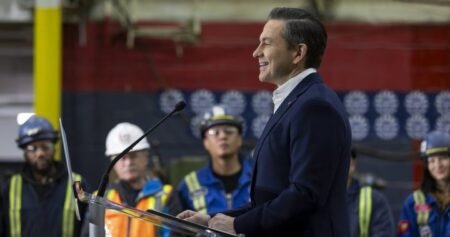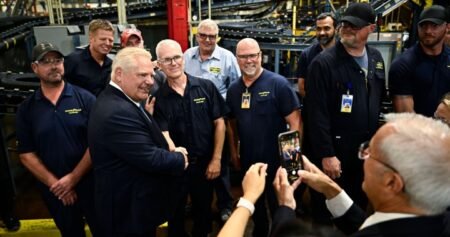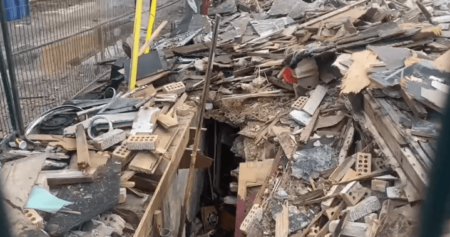Ferenc Jakab needed heart surgery, and a robot was called into action.
The 60-year-old Ontario resident had been monitoring a heart murmur for over 20 years, checking in with his doctor every couple of years. At a recent visit, the news shifted: it was time for surgery at St. Michael’s Hospital in Toronto.
Jakab was healthy, active and symptom-free, working out regularly and even DJing on the side. But doctors warned the condition could get riskier with age, so they made the call to fix the murmur now.
“They said now is the time because you look good, you’re 60, with no other issues, so you should do this surgery when you are strong and it’s easier to recover,” he told Global News. “And I told them, ‘Why not? Let’s go do it.’”
After hearing this news, he and his wife had joked about how the surgery might go.
“We were talking about the approach, and I said, ‘Hey, maybe they’ll use robots,’” he said, laughing.
“And the next day, I’m at work, and the phone rings [and the doctor] says, ‘You’re a candidate for robotic surgery.’”
Jakab spent the night researching robotic surgery — a technique that’s quickly gaining ground in Canada as more hospitals begin using it for procedures like hip and knee replacements, spinal operations and hysterectomies.
The appeal? Robotic surgery often means smaller incisions, less pain, a lower risk of infection and a much faster recovery.
But there was just one small catch to this procedure — Jakab would be the first patient in the Greater Toronto Area to get robotic heart surgery. Still, he wasn’t too concerned and said the benefits outweigh the risks.
“The robot’s name is Da Vinci. The future is full of robots now, so I said, ‘Why not?’”
On March 26, Da Vinci the robot, along with a team of trained heart surgeons, nurses and anesthesiologists, performed the groundbreaking procedure — marking the first robotic heart surgery of its kind in the Greater Toronto Area, and one of only around five done across Canada.
Some might imagine robotic surgery as just a single robot working alone, but that’s far from the reality, said Dr. Bobby Yanagawa, a heart surgeon and the head of the division of cardiac surgery at St. Michael’s Hospital.
“It’s the surgeon really controlling the hands of the robot,” he said.

Get weekly health news
Receive the latest medical news and health information delivered to you every Sunday.
“So it’s at a robotic console, there are nursing teams that are at the patient’s side, ready to intervene and also to help. There are anesthesia colleagues who are at the head of the table, keeping the patient safe during the operation.”
So, with a whole team involved, what’s the point of using the robot in the first place?
The advantage of the robot is that its instruments are much smaller than a surgeon’s hands, Yanagawa explained.
Robotic surgery, he said, allows for much smaller incisions compared with traditional methods. While a larger incision would typically be needed to access certain areas, the robot’s precision instruments can fit through tiny openings.
As a result, after procedures like robotic mitral surgery, the incisions are so small that, even a year later, it’s often difficult to tell the person had surgery at all, he added.
A 2023 study published in the Journal of Thoracic Disease looked at how robotic-assisted heart surgeries using the Da Vinci system stack up against the traditional open-heart approach. They found that patients who had the robotic procedures typically spent less time in the ICU and got out of the hospital sooner. Overall, their recovery outcomes were better.
The researchers also noted that while the Da Vinci system is both safe and effective, it does take some time and training for surgeons to get the hang of it.
“Robotic surgery can be considered the pinnacle of heart surgery. And I say that because one has to be very comfortable with the type of surgery we’re doing, mitral surgery, through a big open sternotomy. And that takes a couple hundred cases [of practice],” Yanagawa said.
While robotic surgery offers significant advantages, it still demands highly skilled surgeons to operate it. That’s where Dr. Daniel Burns and Dr. John Luigi Bisleri, the two cardiac surgeons who worked on Jakab’s heart, come in.
Bisleri, a cardiac surgeon and the director of minimally invasive cardiac surgery at St. Michael’s Hospital, helped perform the robotic surgery. He said robotic surgery is a crucial tool in ongoing efforts to minimize patient trauma and improve recovery times.
“The real huge impact is the early post-operative recovery compared to patients undergoing conventional surgery, and also can return way faster to routine activity,” he said.
Burns, a cardiac surgeon at St. Michael’s Hospital and a clinician-scientist investigating organ injury and repair, said there are major benefits to using the robot, like better dexterity and clearer visualization compared with the traditional approach.
“One of the common criticisms [of robotic surgery] is the lack of tactile feedback; I can’t feel what I’m doing. And perhaps this is me growing up as a video gamer but I found that a very easy hurdle to clear,” he said.
Jakab said he woke up after surgery with just a bit of pain. The first couple of nights were rough, mostly because of the tubes and some back and neck aches, but once the IV came out, he started feeling much better. From there, things kept improving.
His surgery was a success, with a perfect valve repair and no residual leak. He was discharged on the third day after the operation.
Patients usually recover faster after robotic heart surgery because instead of cutting through the breastbone, the robot lets surgeons access the heart through small openings between the ribs, Yanagawa said. This makes recovery potentially much quicker.
He said patients could be back on their feet in just a week or two — quite a jump from the usual three to four months it takes to recover from a traditional sternotomy.
“When we went home, I was telling my wife, I can’t believe it, we are home already. And I am not 100 per cent, but I am feeling OK,” Jakab said.
Jakab had such a positive experience that he has some advice for anyone considering robotic surgery.
“Just do it. I read about how robotic surgery is more precise, with less blood loss and an easier recovery — that’s what convinced me,” he said.
Robotic surgery is still relatively uncommon in Canada, according to a 2022 study published in the Canadian Journal of Surgery.
At the time of the study, 30 surgical robots were operating across 14 cities, performing roughly 6,000 procedures every year.
The study also noted that robotic-assisted surgery isn’t funded by the Canadian public health-care system and instead depends entirely on philanthropic and research support — a key factor limiting wider patient access.
But surgeons like Bislari believe we’re only scratching the surface of what robotic surgery can do.
“I think this is going to be an incredible, powerful tool that will continue to push our ability to drastically change how we treat heart disease,” he said. “And I think we’re now going to be seeing an exponential growth in these procedures and further innovations that will continue to impact patients’ care.”
Yanagawa agreed.
Although it’s difficult to predict the future, he said, he still wants to be part of it.
“We want part of the business, and we want to be part of leading the change,” he said.
“The truth is that in Canada, and really around the world, probably much, much less than one per cent of heart surgery is done robotically. And if that becomes five, 10, 20, 25 per cent, then we don’t want to be left behind. We want to be at the forefront.”
Read the full article here
















